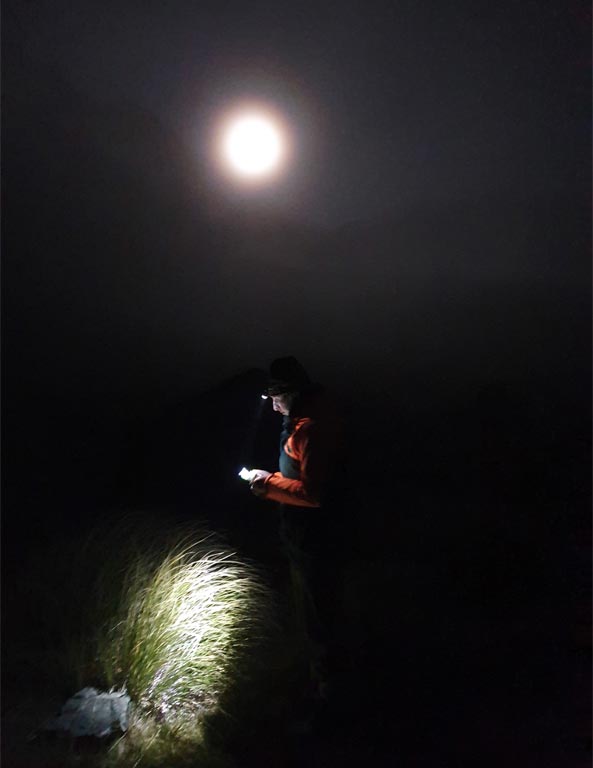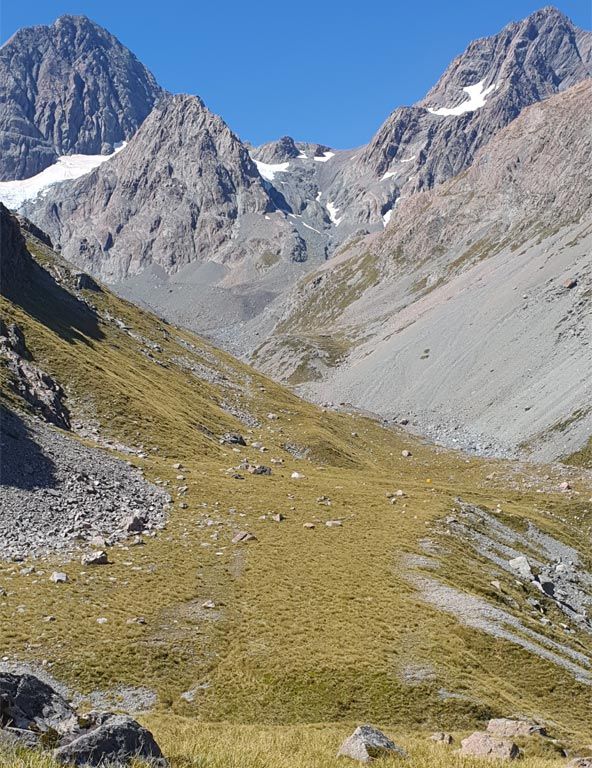The New Zealand mountain stone wētā is a superhero of the invertebrate world possessing powers worthy of character inclusion in the Marvel Cinematic Universe. Found in the alpine zone above the tree line of the Southern Alps, it’s the largest insect able to be frozen in time without dying.
While wētā may lack the cute and cuddly appeal of birds, they are the insect equivalent of the distinctively New Zealand moa, takahē or kakapo. They have been around long enough to see dinosaurs come and go, and with their big bodies, spiny legs and curved tusks, they are one of New Zealand’s most recognisable creepy-crawlies.
New Zealand boasts more than 100 species of wētā, of which the mountain stone wētā deserves the public’s admiration, says Department of Conservation (DOC) invertebrate ecologist Warren Chinn, who has been with DOC’s terrestrial ecosystem unit for the past decade. ‘People should know about them. They’re pretty amazing.’
The mountain stone wētā or Hemideina maori, is a large, flightless, nocturnal relative of the grasshopper which is only found in old riverbeds and terraces on the eastern side of the Main Divide from Marlborough to Southern Otago, living at an altitudinal range between 1,000–1,500 m above sea level.
It’s endured and thrived here for more than 60–80 million years. The mountain stone wētā has the same deep ancestors as king crickets in Australia and Parktown prawns in South Africa, providing evidence they were once found all over parts of the supercontinent Gondwanaland before fragmentation.
Strictly, it’s a tree wētā, but strangely it lives in areas devoid of trees. ‘It’s the oddball,’ explains Warren. ‘It hides under laptop-sized stones on the ground rather than sheltering in tree holes, exploiting the habitat niche that was available to it after the crude division of habitat around 7 million years ago with the uplift of the Southern Alps.’
It’s a tough habitat for an insect with temperatures fluctuating between 50 to 60 degrees in a day. Hard frosts or snow are possible, even in the middle of summer, with night-time temperatures plummeting well below freezing. Over time though, the mountain stone wētā has adapted.
Mountain stone wētā survive on berries from the Gaultheria antipoda (commonly known as snowberry) or Raoulia plants which can be found in old riverbeds, and decaying matter from other insects.
They are nocturnal, travelling tens of metres at night, but populations are highly fragmented with mountain stone wētā sticking to rocky areas using cavities under rock slabs (‘tors’) as retreats during the day, which are separated by alpine meadows with no rocks.
Fragmentation has also led to local colour variances with mountain stone wētā having two distinct colourations – almost wasp-like yellow and black stripes, and mahogany brown with striped abdomen. ‘Most of our insects are brown or black and pretty boring, but these are fantastic. They look quite striking,’ says Warren.
Despite their harsh environment, the mountain stone wētā are long-lived (for an insect). ‘There is a lot to be gained from being large, with mountain stone wētā reaching up to 55–60 mm in length. They’re generally 40–45 mm,’ says Warren.
A successful male mountain stone wētā lives with a harem of three to four females. They tend to breed before the real cold weather hits but are known for being slow breeders, producing low numbers of offspring.
Contrary to most insects, the mountain stone wētā are ‘semi-metabolous’ and do not go through a metamorphic lifecycle. ‘What comes out is a nymph – a miniature version of the adult. It’s a huge advantage to them. They start off small, but they can move out of harm’s way, move around and find food,’ explains Warren.
Growth occurs through a series of moults. Each moult involves splitting their skin, working their way out of it and finally inflating themselves to a bigger size before the outer skin hardens. During this process, they are extremely vulnerable, so it occurs under the cover of darkness.
Undoubtedly their most remarkable feat though is the mountain stone wētā’s ability to survive being seemingly frozen solid. Once it warms up, it simply thaws and resumes life. What’s more, it can withstand repeated cycles of being frozen and then thawed, and comes out alive and kicking every time. Most life forms can’t survive being frozen as the water expands when freezing, forming ice crystals, which means any water in cells will burst the cell’s membrane with disastrous effects.
Humans have spent decades trying to work out how to be cryogenically preserved, frozen in time, and then woken up later, and at this stage, it’s still not possible. And yet, mountain stone wētā do it regularly, explains Warren.
The key difference is the mountain stone wētā’s blood, called hemolymph. Unlike some species of insect that have a natural antifreeze in their blood, hemolymph is jam-packed full of glycoproteins which allow the mountain stone wētā to freeze 82 per cent of the fluids in its body without damaging the cells, meaning it can survive temperatures down to -8 degrees Celsius for long periods.
They have also developed their own unique defence mechanism. ‘It lies on its back and plays dead with its legs in the air and jaws wide open to fool predators – and if that doesn’t work, it scratches, bites and vomits on them,’ says Warren.
While mountain stone wētā have survived happily for millions of years, Warren has his concerns about its future going forward due to human impacts through changes in land-use, genetic drift in isolation, climate change and the increase of mammalian predators in the alpine zone. ‘They’ve had a 12,000-year good run, but that may be changing. As temperatures increase, more and more predators are pushing up into the alpine zone. They [wētā] are sitting ducks for rodents and stoats,’ he says.
It’s hoped that monitoring in Te Manahuna Aoraki will provide some much-needed information on numbers. ‘For us to see the full story of biodiversity outcomes of pest control within the bounds of Te Manahuna Aoraki, we need a clear picture of what’s there now and we currently have limited knowledge of the invertebrate populations in the alpine environment,’ says Te Manahuna Aoraki project manager Simone Cleland.
Mountain stone wētā will not yet be benefitting from any predator control work as to date the majority has been carried out below 1,100 m. In the third year of a feasibility phase, if Te Manahuna Aoraki transitions into a 20-year long-term plan, predator control is to be extended up to 1,900 m. ‘That’s when we’d hope to see an increase in numbers,’ explains Simone.
Earlier this year, teams from Te Manahuna Aoraki headed up into the top of the Whale Stream, Beetham Valley and Mt Stevenson, setting 20 m transects spaced 5 m apart to search for mountain stone wētā. Each was checked five times in the two hours after dark. It was repeated for three nights.
‘We are finding that they are sensitive to weather and temperature, and we will be using that information as well and comparing it. Because they are nocturnal and live in a challenging environment we are testing several different methods so we can single out the most effective one for measuring them.’
Simone says while mountain stone wētā were present at all sites, it was too early to draw any conclusions. ‘This is our baseline. In five years we will know best how to measure them and what the numbers are.’
Recent stories

All Rights Reserved | CountryWide Media





